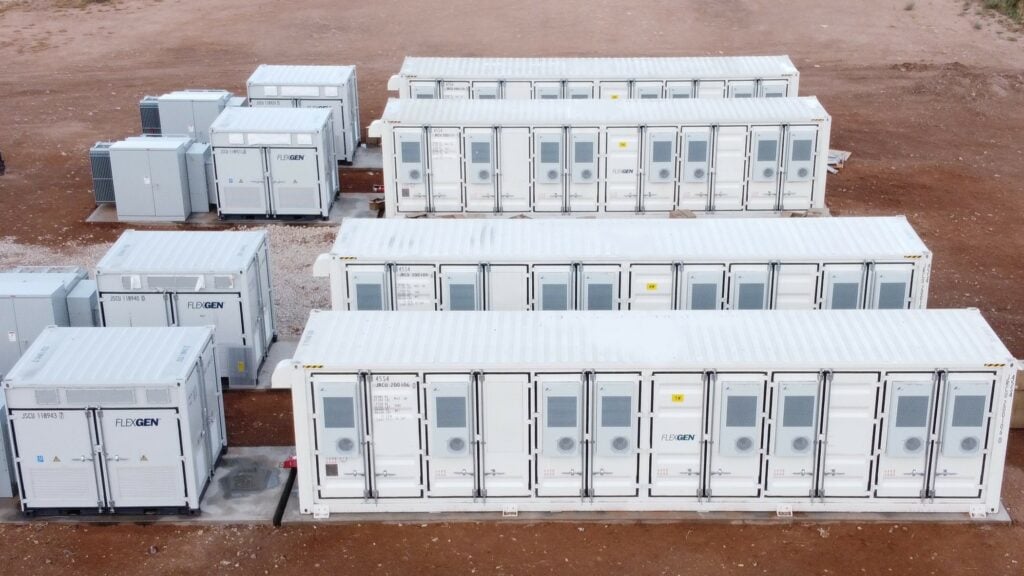
FlexGen Power Systems will provide 2.1GWh of battery storage solutions to a project in California which exemplifies the state’s “leadership” in the transition to a modern, cleaner grid, the company’s CEO has said.
FlexGen has been selected by clean energy solutions company Ameresco to provide battery energy storage system (BESS) technology and software for the entire 537.5MW / 2,150MWh portfolio, across three sites in southern California.
Enjoy 12 months of exclusive analysis
- Regular insight and analysis of the industry’s biggest developments
- In-depth interviews with the industry’s leading figures
- Annual digital subscription to the PV Tech Power journal
- Discounts on Solar Media’s portfolio of events, in-person and virtual
Or continue reading this article for free
Energy-Storage.news reported in October as Ameresco was picked as engineering, procurement and construction (EPC) and maintenance partner for the portfolio by California investor-owned utility (IOU) Southern California Edison (SCE).
Seeking to help mitigate an extreme energy shortfall that California experiences, particularly at peak times in summer which could potentially add up to about 5GW, the BESS projects in and around the San Joaquin Valley, Rancho Cucamonga and Long Beach areas of the state will charge from the grid during off-peak times and times of excess generation such as when solar is abundant in the daytime.
The energy stored in the four-hour battery systems will then be discharged to the grid as needed by SCE when demand peaks.
The project has been made possible by California’s governor Gavin Newsom’s declaration this summer of an emergency and enactment of legislation to expedite renewable energy and energy storage projects for the grid.
“In a lot of ways, this is a landmark project. Kudos to California for really showing leadership in this grid transition,” FlexGen CEO Kelcy Pegler told Energy-Storage.news in an interview.
“There’s a lot of eyes on this project, California and beyond will be looking at this.”
Battery storage can offer a lot to that transition, Pegler said, as it can sit at the intersection between the the legacy power production facilities of the grid and newer, “clean and green” assets — “which just happen to be intermittent”.
The utility will own the battery storage assets, which will be connected to substations on its distribution network. Ameresco has previously said that the projects will be commissioned and in commercial operation by August 2022.
“California has really set the tone by providing the emergency approvals for this project slate,” Pegler said, adding that FlexGen will be working with “real urgency,” as will everybody else involved.
FlexGen’s software approach was key to selection
Pegler said that FlexGen’s software, Hybrid OS, which runs and monitors its battery projects, was central to the value proposition that won over Ameresco in a selection process.
FlexGen has decade-long roots in energy storage of different types, beginning primarily as a microgrid project company working for customers including the military, delivering mission-critical power on a distributed level. From there, its projects have included the optimisation of efficiency at thermal power plants, as well as standalone battery storage and renewable storage.
Throughout that history, Hybrid OS has been ever-present, built over several years with “tens of millions of dollars of invested capital”. It’s most meaningful attribute to this project, CEO Pegler said, is that the software was never designed as a money-making, market-facing platform.
“It was conceived to provide the software and the controls and the platform to operate battery storage for as long as battery storage has existed and that’s meant different things at different times.
“In its earliest days, that was military microgrids. As technologies and use cases evolved that became hybridised oil and gas fields, all the way to today, to a momentous project with SCE and Ameresco, where we’ll be providing backup battery to make the grid more reliable, and intelligent.”
Since training its focus primarily onto grid storage projects, FlexGen has integrated and deployed lithium-ion BESS in various US markets, with an emphasis on Texas where it is one of the most prolific integrators in the state’s ERCOT electricity market.
In August the company raised an US$150 million equity investment from alternative asset management group Apollo Global Management. At the time Pegler said the investment “advantaged” FlexGen in an increasingly competitive market.
